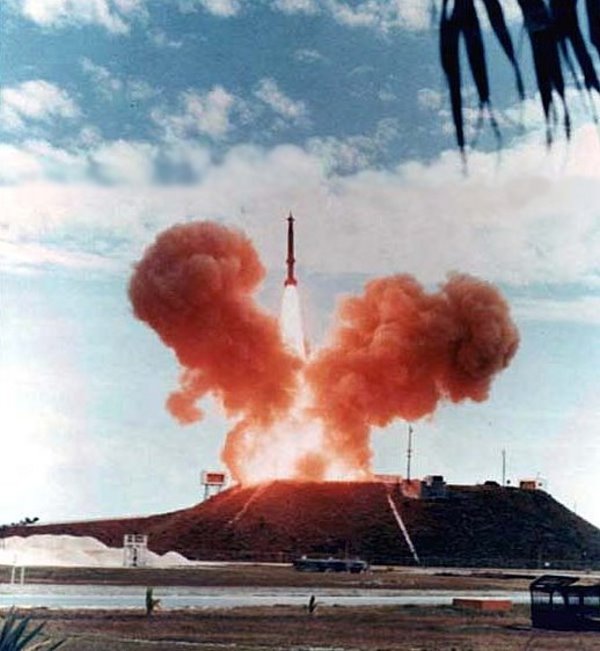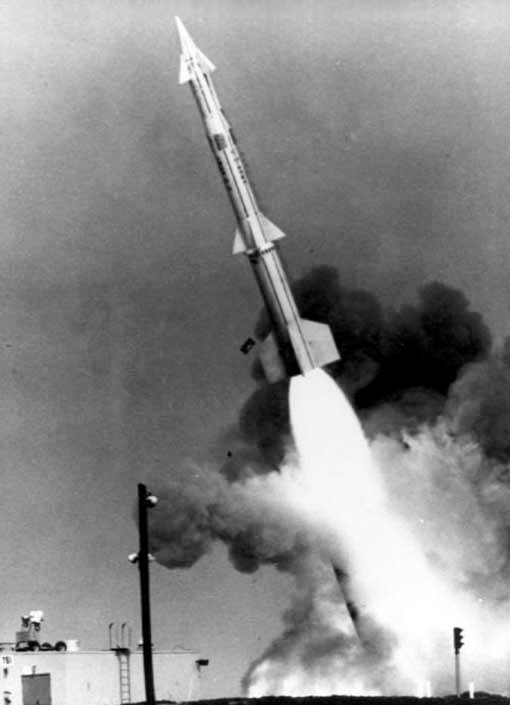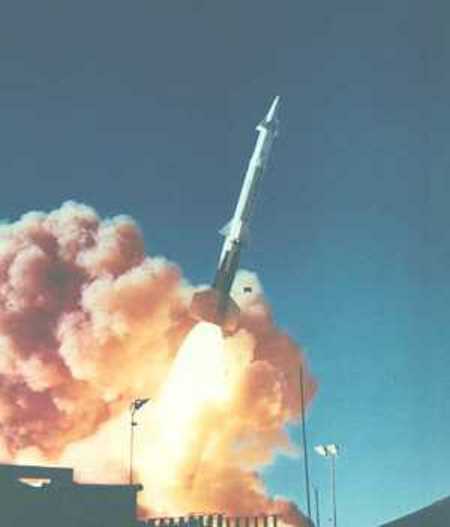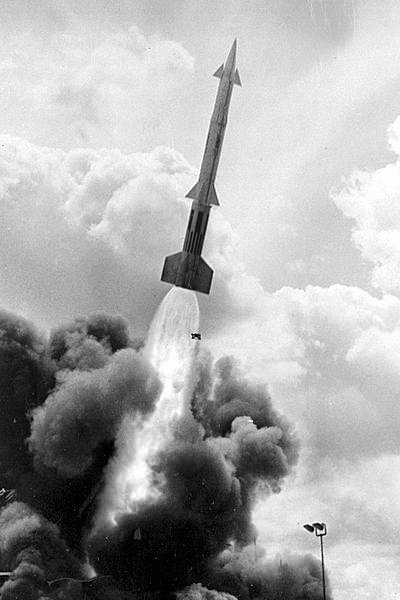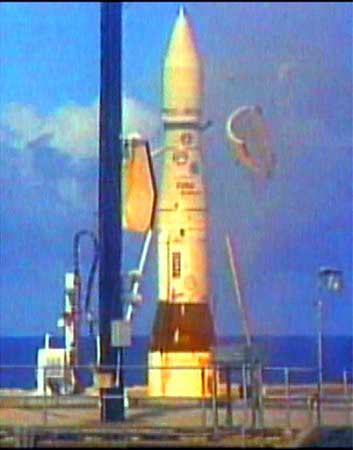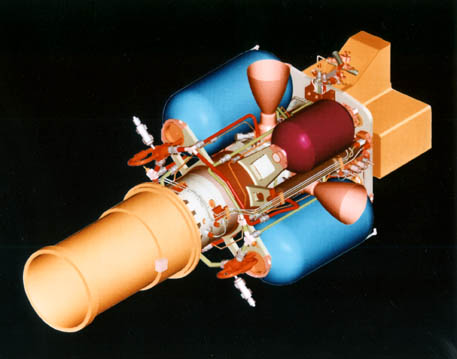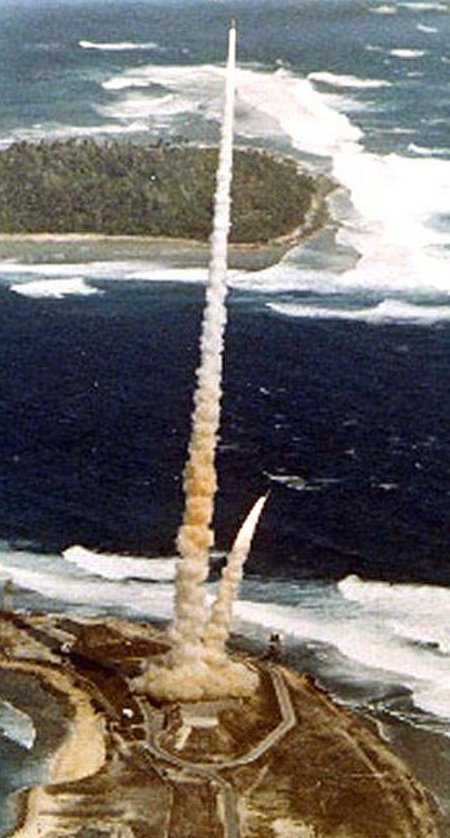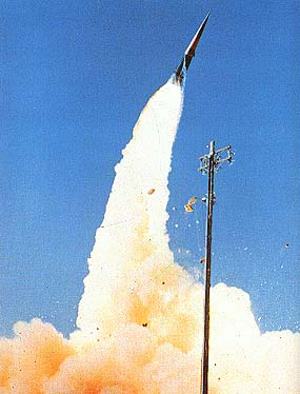|
|
||
|
|
||
|
..
Spartan launch from Mount Olympus ..
Rail Launch |
||
|
No. 520-02 October 14, 2002 The Missile Defense Agency (MDA) announced today it has successfully completed a flight test of the ground-based midcourse defense (GMD) development program, intercepting an intercontinental ballistic missile target. The test took place over the central Pacific Ocean in the Western Test Range. A modified Minuteman intercontinental ballistic missile target vehicle was launched from Vandenberg Air Force Base, Calif., at 10 p.m. EDT, and a prototype interceptor was launched 22 minutes later and 4,800 miles away from the Ronald Reagan Missile Site Kwajalein Atoll in the Republic of the Marshall Islands. The intercept took place approximately six minutes after the interceptor was launched, at an altitude in excess of 140 miles above the earth, and during the midcourse phase of the target warhead's flight. This was the fifth successful intercept--and the fourth consecutive--in seven flight tests since October 1999 for the GMD program. This test involved for the first time the participation of a U.S. Navy Aegis destroyer, the USS John Paul Jones, using its SPY-1 radar system. Although the radar was not integrated into the battle management system for the intercept, it did gather important data on the capabilities of the radar against a long-range ballistic missile. Future tests will include direct participation of the radar in order to determine its potential capability against long-range missiles. This system-level test successfully demonstrated "hit to kill" technology to intercept and destroy a long-range ballistic missile target. In addition to the exoatmospheric kill vehicle (EKV) locating, tracking, and intercepting the target resulting in its destruction using only body-to-body impact, this test also demonstrated the successful integrated operation of space and ground-based sensors and radars, as well as the Battle Management, Command, Control and Communications System (BMC3) function to detect the launch of the target missile, cue an early warning radar to provide more detailed target location data; and integration of a prototype X-Band radar (based at Kwajalein) to provide precise target data to the EKV, which received the target updates from the In-Flight Interceptor Communications Systems (IFICS) at Kwajalein. The EKV separated from its rocket booster more than 1,400 miles from the target warhead. After separation, it used its on-board infrared and visual sensors, augmented with the X-Band radar data provided by BMC3 via the In-flight Interceptor Communications System, to locate and track the target. Sensors aboard the EKV also successfully selected the mock warhead from among the five objects in the target array, including three decoys. Only system-generated data was used for the intercept after the EKV separated from its booster rocket. This test is a major step in an aggressive developmental test program, and we will continue to pursue this testing regime to achieve a layered approach to missile defense, using different architectures to deter the growing threat of ballistic missiles carrying weapons of mass destruction. Over the next several weeks, government and industry program officials will conduct an extensive analysis of the data received during the flight test to determine whether anomalies or malfunctions occurred during the test, evaluate system performance and determine whether or not all flight test objectives were met. Since the system is in the developmental phase of design and testing, performance of individual elements and the overall system integration was as important as the actual intercept. News media points of contact are Cheryl Irwin, Defense Department Public Affairs, at (703) 697-5331, and Lt. Col. Rick Lehner, MDA External Affairs, at (703) 697-8997. SOURCE: Department of Defense |
||
|
..
Nike Zeus B ...
Nike Zeus |
||
|
No. 127-02 March 15, 2002 ...
...
The Missile Defense Agency (MDA) announced today it has successfully completed a test involving a planned intercept of an intercontinental ballistic missile target. The test took place over the central Pacific Ocean. A modified Minuteman intercontinental ballistic missile (ICBM) target vehicle was launched from Vandenberg Air Force Base, Calif., at 9:11 p.m. EST, and a prototype interceptor was launched approximately 20 minutes later and 4,800 miles away from the Ronald Reagan Missile Site, Kwajalein Atoll, in the Republic of the Marshall Islands. The intercept took place approximately 10 minutes after the interceptor was launched, at an altitude in excess of 140 miles above the earth and during the midcourse phase of the target warhead's flight. This was the fourth successful intercept for the Ground-based Midcourse Defense (GMD) Segment, formerly known as National Missile Defense. The test successfully demonstrated exoatmospheric kill vehicle (EKV) flight performance and "hit to kill" technology to intercept and destroy a long-range ballistic missile target. In addition to the EKV locating, tracking, and intercepting the target resulting in its destruction using only the body-to-body impact, this test also demonstrated the ability of system elements to work together as an integrated system. The test involved the successful integrated operation of space and ground-based sensors and radars, as well as the Battle Management, Command Control and Communications (BMC3) function to detect the launch of the target missile, cue an early warning radar to provide more detailed target location data; and integration of a prototype X-Band radar (based at Kwajalein) to provide precise target data to the EKV, which received the target updates from the In-Flight Interceptor Communications Systems (IFICS) at Kwajalein. The EKV separated from its rocket booster more than 1,400 miles from the target warhead. After separation, it used its on-board infrared and visual sensors, augmented with the X-Band radar data provided by BMC3 via the In-flight Interceptor Communications System, to locate and track the target. Sensors aboard the EKV also successfully selected the target instead of three balloon decoys. Only system-generated data was used for the intercept after the EKV separated from its booster rocket. A C-band transponder aboard the target warhead did not provide any tracking or targeting information to the interceptor after the interceptor was launched. Tonight's test is a major step in our aggressive developmental test program, and is the fourth successful intercept in six attempts. We will continue to pursue this testing regime to achieve a layered approach to missile defense, using different architectures to deter the growing threat of ballistic missiles carrying weapons of mass destruction. Over the next several weeks, government and industry program officials will conduct an extensive analysis of the data received during the flight test to determine whether anomalies or malfunctions occurred during the test, evaluate system performance and determine whether or not all flight test objectives were met. Since the system is in the developmental phase of design and testing, performance of individual elements and the overall system integration was as important as the actual intercept. News media points of contact are Cheryl Irwin, DoD Public Affairs, at 703-697-5331, and Lt. Col. Rick Lehner, MDA External Affairs, at 703-697-8997. SOURCE: Department of Defense |
||
|
..
The Sprint's exit velocity was so fast that its skin glowed in the daytime. ..
Sprint |
||
| Missile Defense Test Score Goes
Three-in-a-row
By Jim Garamone American Forces Press Service WASHINGTON, March 18, 2002 – A ballistic missile interceptor successfully destroyed a test target March 16 in what Missile Defense Agency officials hope is becoming an almost routine occurrence. The Ground-based Midcourse Defense System's exoatmospheric kill vehicle vaporized a mock nuclear warhead on impact 140 miles over the Pacific. The hit-to-kill vehicle distinguished the mock warhead from decoys and other debris. The March 16 test was the third success in a row and fourth out of six tries. Missile Defense Agency officials said the test was in keeping with the program's intent to make each test more challenging than the last. Specialists began the test by launching a modified Minuteman ICBM from Vandenberg Air Force Base, Calif., at 9:11 p.m. EST. A prototype interceptor took off from the Ronald Reagan Missile Range on Kwajalein Atoll about 20 minutes later. The interceptor hit the warhead about 10 minutes after launch. The test demonstrated the ability of system elements to work together and with other systems that watch for potential offensive launches and that alert early warning radar, officials said. Each test of the missile defense system costs about $100 million, Defense Department officials have said. The Missile Defense Agency is aiming to conduct quarterly tests. The next is set for June or July, officials said. This system is just one piece of the total U.S. missile defense effort. The Defense Department is also working on an airborne laser to hit missiles in the boost phase and the Patriot Advanced Capabilities 3 system for terminal phase defense. The Missile Defense Agency finished the research and development phase of the PAC 3 and turned it over to the Army, which is scheduled to test the PAC 3 before the end of March. SOURCE: Department of Defense Related Sites:
|
||
| REFERENCE LINKS: | ||
| FAIR USE NOTICE: This page contains copyrighted material the use of which has not been specifically authorized by the copyright owner. Pegasus Research Consortium distributes this material without profit to those who have expressed a prior interest in receiving the included information for research and educational purposes. We believe this constitutes a fair use of any such copyrighted material as provided for in 17 U.S.C § 107. If you wish to use copyrighted material from this site for purposes of your own that go beyond fair use, you must obtain permission from the copyright owner. | ||
|
|
